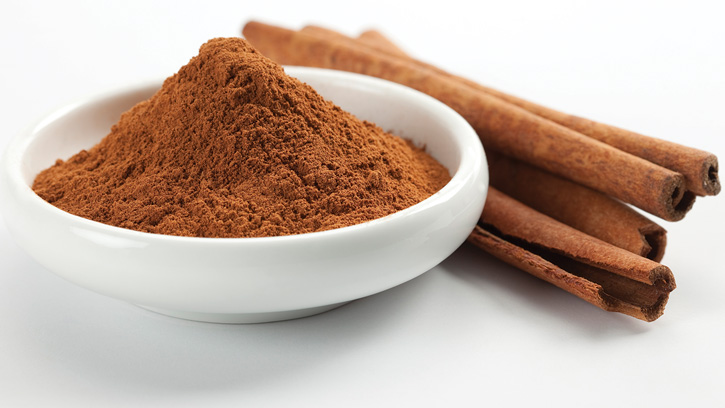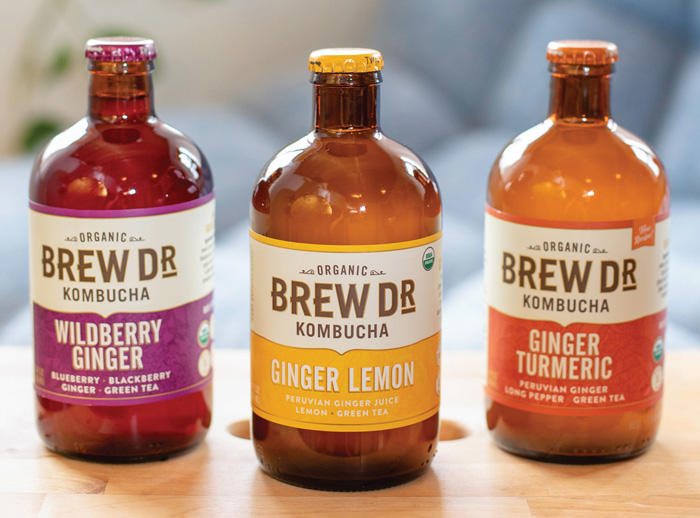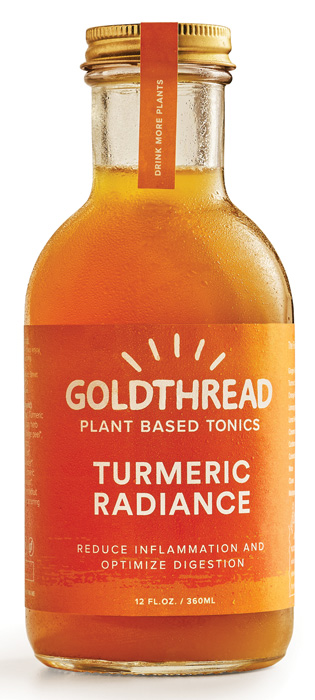Spicy Nutrition
NUTRACEUTICALS
Spices and herbs do more than add flavor to foods and beverages. For one thing, they can often be used to reduce sodium levels. They also meet some of today’s food and beverage trends: natural, clean label, and plant based. In addition, some herbs and spices are thought to be inherently healthy, containing antioxidant and anti-inflammatory compounds that may benefit health.
Lu et al. (2017), for example, demonstrated that some spice extracts displayed prebiotic-like activity by promoting the growth of beneficial bacteria and suppressing the growth of pathogenic bacteria. Extracts from black pepper, cayenne pepper, cinnamon, ginger, Mediterranean oregano, and rosemary enhanced the growth of Bifidobacterium spp. and Lactobacillus spp. The identification and quantification of spice-specific phytochemicals provided insight into the potential influence of these chemicals on gut microbial communities and activities.
Here is a look at some herbs, spices, and extracts and their potential health benefits.
Cayenne Pepper
This spice is associated with pain relief, sore throat/cold relief, and weight management. Some of the reported benefits may be due to the capsaicinoids present in cayenne pepper, with capsaicin being the most common and what gives cayenne pepper its heat. Capsaicinoids have been studied for their potential to increase fat oxidation and metabolism and affect appetite, ultimately contributing to weight management. Irandoost et al. (2020) conducted a meta-analysis of placebo-controlled clinical trials between 1990 and 2019 to examine the effect of capsaicinoids or capsinoids (non-pungent) on thermogenesis indices. The 13 studies included in the meta-analysis showed that researchers observed moderate improvement in resting metabolic rate, respiratory quotient, and fat oxidation following supplementation with capsaicinoids/capsinoids, but also noted that further high-quality studies are required to clarify their thermogenic properties.
Capsimax is a self-affirmed GRAS concentrated extract of capsaicinoids from red chili peppers (Capsicum annum) offered by OmniActive Health Technologies. The company’s patented OmniBead Beadlet Technology encapsulates the capsaicinoids, allowing for consumption in efficacious amounts without stomach discomfort. Rogers et al. (2018) showed that in a 12-wk study, post-hoc analysis revealed a change in body fat and fat mass in people taking four mg capsaicinoids (Capsimax) compared with the placebo. In a separate study with Capsimax, Urbina et al. (2017) showed that those taking 4 mg/day capsaicinoids consumed fewer calories/day than the placebo group.
According to OmniActive, the capsaicinoids in Capsimax are absorbed through the gastrointestinal tract and distributed throughout the body. Their ability to influence energy metabolism and weight management are tied to activation of sarcoplasmic reticulum Ca+-ATP-ase (SERCA) and uncoupling protein (UCP1), and transient receptor potential cation channel subtype 1 (TRVP1). Both SERCA and UCP1 convert the working energy in ATP that is normally used by muscles and other biological processes into heat energy. TRVP1 (capsaicin receptors) are found in sensory tissue, such as the mouth, as well as gastrointestinal, adipose, and liver tissues. Activation of TRVP1 may reduce visceral adipose tissue by increasing lipolysis and fat oxidation and reducing appetite.
Cinnamon
Cinnamon supplements are often taken to help manage blood glucose levels by possibly lowering insulin resistance or helping the body use insulin more efficiently. Romeo et al. (2020) studied individuals with prediabetes and the influence of cinnamon (500 mg thrice daily) on glycemic control. After 12 wk of cinnamon supplementation, researchers noted improved fasting plasma glucose levels and glucose tolerance. They added that longer and larger studies would address cinnamon’s effects on the rate of progression from prediabetes to type 2 diabetes.
Cinnamon has also been studied for potential benefits in weight management. Cinnamaldehyde, a cinnamon extract, has been shown to activate thermogenic and metabolic responses in mouse and human adipose cells (Jiang et al. 2017).
Garlic
Botanically, garlic is a vegetable, but it is used as a spice. Garlic supplements have been shown to benefit blood pressure as well as cholesterol levels. Xiong et al. (2015) conducted a review and meta-analysis of studies looking at garlic and its effects on hypertension. A total of seven randomized, placebo-controlled trials were identified for the meta-analysis. Researchers found a significant lowering effect of garlic on both systolic blood pressure and diastolic blood pressure, however they noted that more rigorously designed randomized controlled trials focusing on primary endpoints with long-term follow-up are still needed before garlic can be recommended to treat hypertensive patients.
In a separate literature review, Varshney and Budoff (2016) also concluded that garlic supplementation has the potential for cardiovascular protection based on risk factor reduction (hypertension and total cholesterol) and surrogate markers (C-reactive protein, pulse wave velocity, and coronary artery calcium) of atherosclerosis. In the studies, which looked at garlic supplementation, both systolic and diastolic blood pressure and total cholesterol were reduced. The most consistent benefits were shown in studies that used aged garlic extract.
Ginger
Ginger is often taken for nausea and motion sickness. Maharlouei et al. (2019) conducted a meta-analysis to summarize the effect of ginger intake on weight loss, glycemic control, and lipid profiles among overweight and obese subjects. Fourteen randomized controlled trials were included in the meta-analysis. The results indicated that the supplementation with ginger significantly decreased body weight, waist-to-hip ratio, hip ratio, fasting glucose, and insulin resistance index, and significantly increased high-density lipoprotein cholesterol levels, but did not affect insulin, body mass index, triglycerides, nor total- and low-density lipoprotein cholesterol levels.
Kim et al. (2017) studied the anti-inflammatory potential of ginger extract in a cellular model of gut inflammation. It was observed that ginger extract and its constituents improved inflammatory responses by decreasing the levels of nitrite, prostaglandin E2, interleukin-6, and interleukin-8. Results showed that ginger extract may be developed as a functional food for the maintenance of gastrointestinal health.
Rosemary
This spice is used as a natural antioxidant for food preservation. Because of its antioxidant properties, it has also demonstrated health benefits. Rosemary and its constituents, including carnosic acid, rosmarinic acid, and carnosol, have benefits such as anti-inflammatory, antioxidant, antimutagenic, antibacterial, antiviral, antinociceptive, and neuroprotective activities. Alavi et al. (2020) reviewed literature focusing on the protective effects of rosemary and its main compounds against natural and chemical toxicities in both in vitro and in vivo studies. The protective effects of rosemary and its components are mostly mediated through different mechanisms such as the inhibition of oxidative stress, reduction of inflammatory mediators, as well as the modulation of apoptosis and mitogen-activated protein kinase signaling pathways.
Saffron
Saffron contains crocin, crocetin, safranal, and kaempferol, which function as antioxidants. Saffron has been shown to affect mood and symptoms of depression. Tabeshpour et al. (2017) conducted a trial on 60 new mothers with mild to moderate postpartum depression. They were randomly assigned to the saffron (15 mg/two times per day) or placebo group for eight weeks. Saffron had a more significant impact on the Beck Depression Inventory-Second Edition (BDI-II) scores than the placebo. The mean BDI-II scores decreased more significantly for the saffron group than the placebo group.
PLT Health offers a saffron (Crocus sativus L.) stigma extract, Supresa, which is rich in safranal, crocin, and picrocin. The product, which is standardized to > 0.3% safranal, was developed to support weight management by improving emotional well-being and decreasing snacking behavior. Supresa induces a feeling of well-being and stress reduction to address the source of stress-related overeating and snacking. According to PLT Health, Supresa’s clinically studied formula improves levels of the neurotransmitter serotonin, whereby a sense of well-being is achieved. Serotonin is a neurotransmitter that influences satiety, appetite, mood, compulsiveness, and anxiety.
Turmeric
Turmeric and its polyphenol, curcumin, are among the major spices and spice extracts known for anti-inflammatory properties. Turmeric can be found in supplement aisles and is promoted in snacks and beverages. Goldthread Plant Based Tonics’ Turmeric Radiance, for example, is a functional blend of turmeric, ginger, cinnamon, cardamom, lemongrass, orange peel, lemon verbena, coriander seeds, mace, cloves, and Madagascar vanilla.
In an overview of research regarding the health benefits of curcumin, Hewlings and Kalman (2017) wrote that research suggests that curcumin can help in the management of oxidative and inflammatory conditions, metabolic syndrome, arthritis, anxiety, and hyperlipidemia. It may also help in the management of exercise-induced inflammation and muscle soreness, thus enhancing recovery and subsequent performance in active people.
Ingredient suppliers offer soluble and bioavailable turmeric extracts or curcumin. Naturex, for example, offers Turmipure Gold, which in January became self-affirmed as GRAS. The ingredient is now authorized for both intuitive and effective daily intake in categories that include beverage and beverage bases, confectionery products, and dairy and dairy analogues. Because of the ingredient’s increased bioavailability, a single 300 mg serving delivers the same amount of curcuminoids to the blood as 1,922 mg of standard turmeric (containing 95% curcuminoids), allowing food and beverage manufacturers to offer tangible benefits to their consumers. Formulated for easy incorporation into food and beverage applications, Turmipure Gold provides instant water dispersibility, a low effective dose, neutral taste, and appealing color. The product has also demonstrated great stability of curcuminoids to heat and light, including in beverages.
OmniActive Health Technologies offers CurcuWIN, a natural turmeric extract with 20% curcuminoids. CurcuWIN is made with OmniActive’s UltraSOL Nutrient Delivery System, which increases the solubility of poorly absorbed nutrients such as curcuminoids.
Oliver et al. (2016) demonstrated that CurcuWIN may protect against cardiovascular diseases by enhancing endothelial function. In the randomized controlled double-blind parallel prospective study, 59 healthy adults were assigned to either placebo, 50 mg, or 200 mg curcumin, for 8 wk. The 200 mg oral curcumin supplementation level resulted in a clinically meaningful improvement in endothelial function, as measured by flow mediated dilation (FMD). The main finding was a clinically substantial 3.0% increase in FMD following 8 wk of high-dose (200 mg) curcumin supplementation and a possible 1.7% improvement following low-dose (50 mg) supplementation.
REFERENCES
Alavi, M. S., S. Fanoudi, M.G. Rahbardar, et al. 2020. “An Updated Review of Protective Effects of Rosemary and its Active Constituents Against Natural and Chemical Toxicities.” Phytother. Res. First published Oct. 12. https://doi.org/10.1002/ptr.6894.
Hewlings, S. J. and D. S. Kalman. 2017. Curcumin: A Review of Its Effects on Human Health. Foods 6(10): 92.
Irandoost, P., N. L. Yagin, N. Namazi, et al. 2020. “The Effect of Capsaicinoids or Capsinoids in Red Pepper on Thermogenesis in Healthy Adults: A Systematic Review and Meta-analysis,” Phytother. Res. First published Oct. 15. https://doi.org/10.1002/ptr.6897.
Jiang, J., M. P. Emont, H. Jun, et al. 2017. Cinnamaldehyde Induces Fat Cell-Autonomous Thermogenesis and Metabolic Reprogramming. Metabolism 77: 58–64.
Kim, Y., D.-M. Kim, J. Y. Kim. 2017. “Ginger Extract Suppresses Inflammatory Response and Maintains Barrier Function in Human Colonic Epithelial Caco-2 Cells Exposed to Inflammatory Mediators.” J. Food Sci. 82(5): 1264–1270.
Lu, Q.-Y., P. H. Summanen, R.-P. Lee, et al. 2017. “Prebiotic Potential and Chemical Composition of Seven Culinary Spice Extracts.” J. Food Science. 82(8): 1807–1813.
Maharlouei, N., R. Tabrizi, K. B. Lankarani, et al. 2019. “The Effects of Ginger Intake on Weight Loss and Metabolic Profiles Among Overweight and Obese Subjects: A Systematic Review and Meta-Analysis of Randomized Controlled Trials.” Crit. Rev. Food Sci. Nutr. 59(11): 1753–1766.
Oliver, J. M., L. Stoner, D. S. Rowlands, et al. 2016. “Novel Form of Curcumin Improves Endothelial Function in Young, Healthy Individuals: A Double-Blind Placebo Controlled Study.” J. Nutr. Metab. Article ID 1089653. https://doi.org/10.1155/2016/1089653.
Rogers J., S. L. Urbina, L. W. Taylor, et al. 2018. “Capsaicinoids Supplementation Decreases Percent Body Fat and Fat Mass: Adjustment Using Covariates in a Post hoc Analysis.” BMC Obesity 5: 22.
Romeo, G. R., J. Lee, C. M. Mulla, et al. 2020. “Influence of Cinnamon on Glycemic Control in Individuals with Prediabetes: A Randomized Controlled Trial.” J. Endocr. Soc. 4(11): bvaa094.
Tabeshpour, J., F. Sobhani, S. A. Sadjadi, et al. 2017. “A Double-Blind, Randomized, Placebo-Controlled Trial of Saffron Stigma (Crocus sativus L.) in Mothers Suffering from Mild-to-Moderate Postpartum Depression.” Phytomedicine 36: 145–152.
Urbina, S. L., M. D. Roberts, W. C. Kephart, et al. 2017. “Effects of Twelve Weeks of Capsaicinoid Supplementation on Body Composition, Appetite and Self-Reported Caloric Intake in Overweight Individuals.” Appetite 113: 264–273.
Varshney R. and M. J. Budoff. 2016. “Garlic and Heart Disease.” J. Nutr. 146(2): 416S–421S.
Xiong, X. J., P. Q. Wang, S. J. Li, et al. 2015. “Garlic for Hypertension: A Systematic Review and Meta-Analysis of Randomized Controlled Trials.” Phytomedicine 22(3): 352–361.








